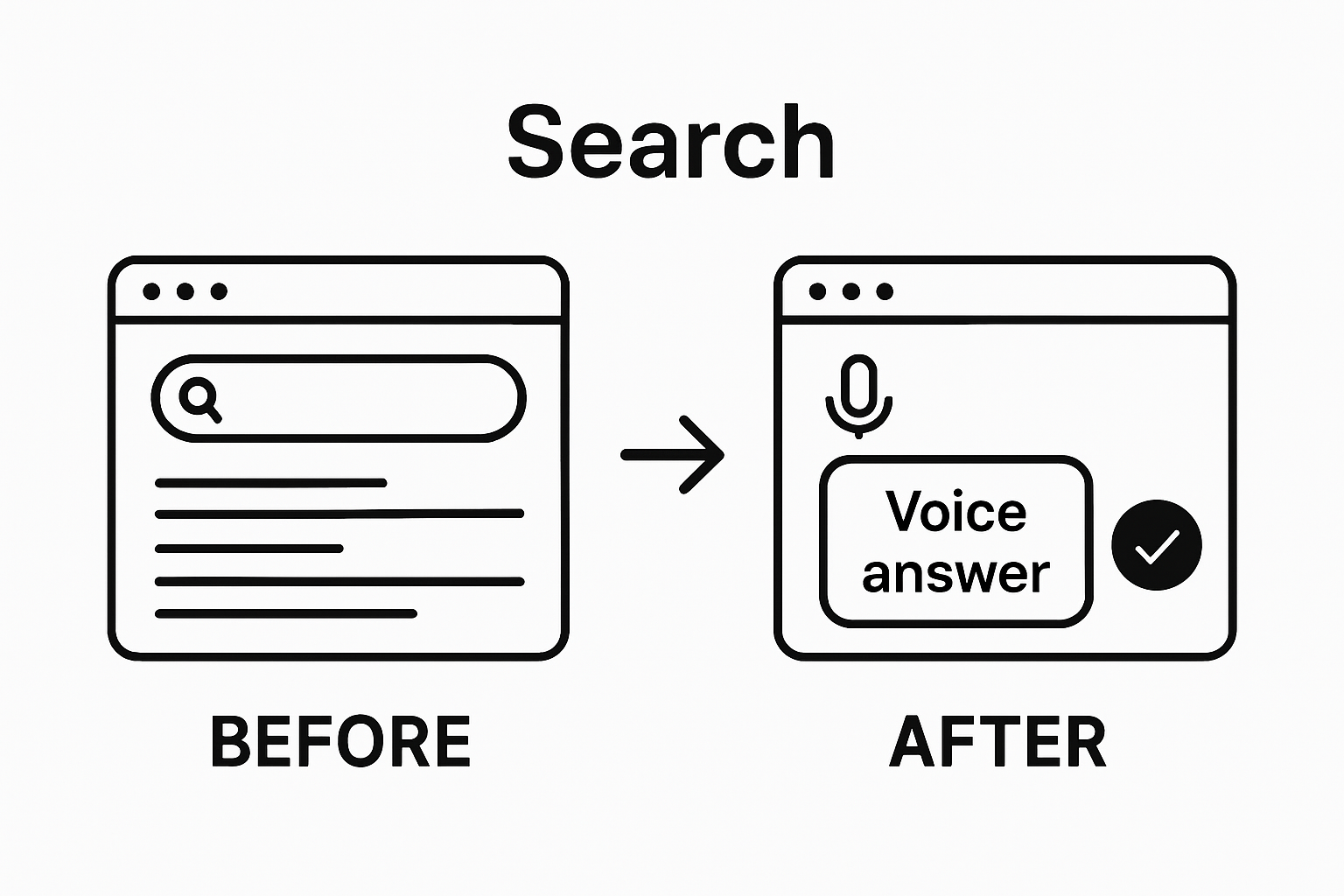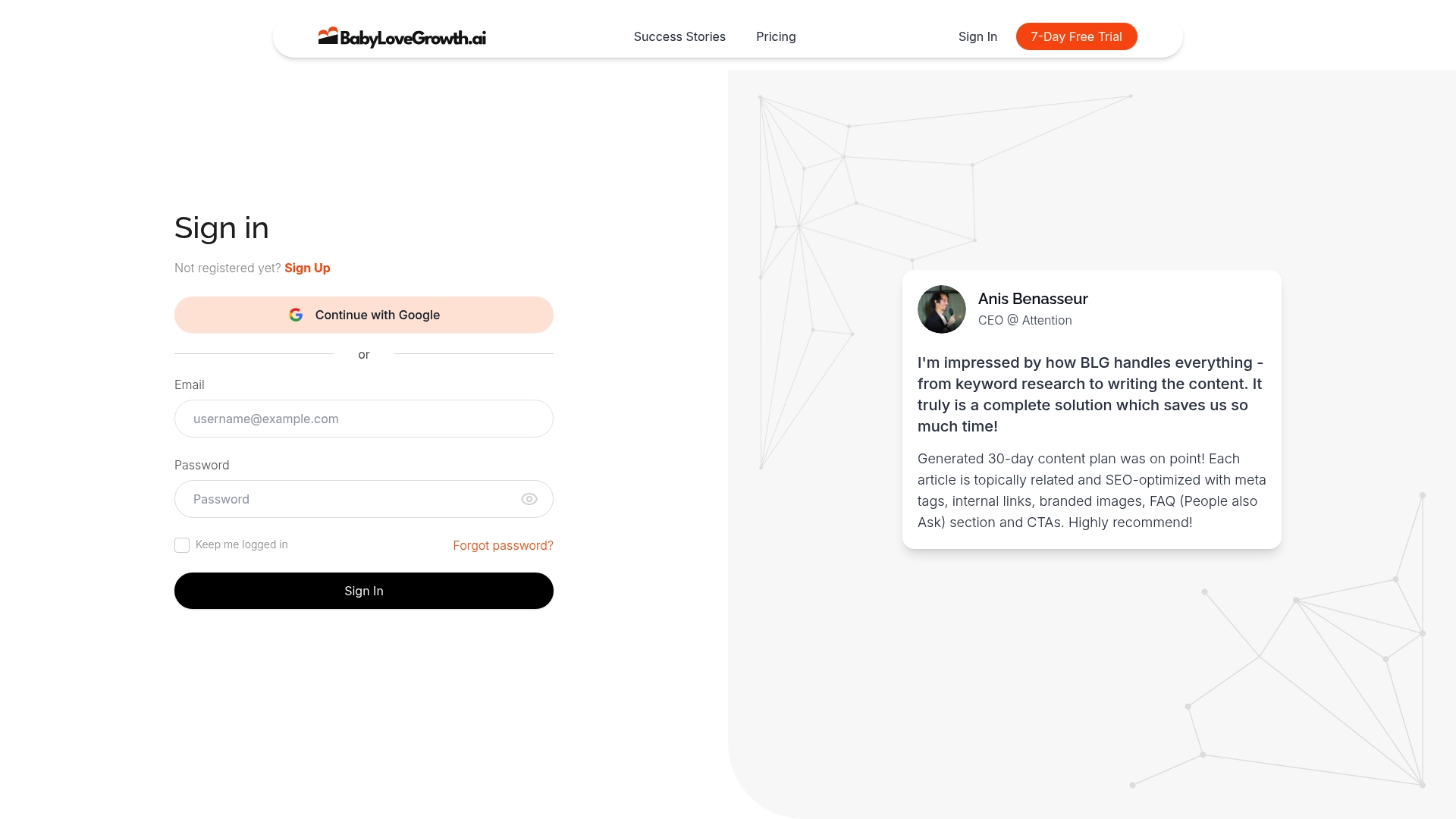How to Optimize for Voice Search in 2025: A Complete Guide


Voice search is taking over how people find information online and by 2024 more than 50 percent of all searches are made using voice commands. That sounds like the future arrived faster than most websites were ready for. Yet the real surprise is that most brands still ignore the simple tweaks that can put them at the top of voice search results. If you know where to look, a few strategic changes can make your content the answer everyone hears first.
Table of Contents
- Step 1: Analyze Your Current SEO Performance
- Step 2: Research Conversational Keywords
- Step 3: Enhance Your Website's Structure
- Step 4: Optimize Content For Voice Queries
- Step 5: Implement Local SEO Strategies
- Step 6: Test And Monitor Voice Search Performance
Quick Summary
| Key Point | Explanation |
|---|---|
| 1. Audit Your SEO Performance | Start by assessing your current keyword rankings and user engagement metrics to identify optimization opportunities for voice search. |
| 2. Research Conversational Keywords | Use tools to find long-tail keywords that reflect natural speech patterns, focusing on how users typically phrase their searches. |
| 3. Enhance Website Structure | Implement schema markup and optimize your website for mobile responsiveness to improve discoverability by voice search algorithms. |
| 4. Optimize Content for Voice Queries | Create concise, conversational content that provides clear answers to potential voice search questions, especially in FAQ sections. |
| 5. Implement Local SEO Strategies | Claim and optimize your Google Business Profile and develop location-specific content to capture voice search queries effectively. |
Step 1: Analyze Your Current SEO Performance
Optimizing for voice search requires a strategic approach that begins with a comprehensive evaluation of your existing SEO performance. Understanding your current digital footprint helps identify the specific areas where voice search optimization can have the most significant impact. Technical SEO metrics and content analysis become crucial in determining your readiness for voice search integration.
Start by conducting a thorough audit of your website's current search performance using tools like Google Search Console and Google Analytics. These platforms provide invaluable insights into your existing keyword rankings, organic traffic patterns, and user engagement metrics. Pay special attention to long-tail keywords and conversational phrases that typically characterize voice search queries. You want to map out how your current content aligns with natural language search patterns.
Your performance analysis should include a detailed examination of your website's mobile responsiveness, page loading speed, and structured data implementation. Voice searches predominantly occur on mobile devices, so ensuring a seamless mobile experience is non-negotiable. Check your mobile page speed using Google's PageSpeed Insights and identify any technical barriers that might impede voice search optimization.
To get more detailed guidance on tracking your SEO performance comprehensively, read our step-by-step SEO tracking guide. This analysis sets the foundation for transforming your digital strategy to capture the emerging voice search market. The goal is not just to understand where you currently stand but to create a strategic roadmap for voice search success.
Key verification points for completing this step include:
- Comprehensive review of current keyword rankings
- Mobile performance assessment
- Structured data implementation check
- Identification of conversational content opportunities
By meticulously analyzing your current SEO performance, you establish a critical baseline that will guide your voice search optimization strategy in the subsequent steps of this process.
Step 2: Research Conversational Keywords
Researching conversational keywords represents a critical transformation in search engine optimization strategies, moving beyond traditional keyword approaches to capture the nuanced language of voice search interactions. Voice search queries demand a more natural, conversational approach that mimics human dialogue. This step focuses on uncovering the precise language patterns users employ when speaking to digital assistants.
Begin by leveraging tools like Google's Keyword Planner, Answer the Public, and SEMrush to identify long-tail keywords that reflect natural speech patterns. These platforms help uncover question-based phrases and conversational queries that people typically use when speaking to voice assistants. Pay close attention to question words like "how," "what," "where," and "why," which are fundamental to voice search interactions. For instance, instead of targeting "pizza delivery," you'll want to optimize for "Where can I find the best pizza delivery near me right now?"
To refine your keyword research strategy, explore our comprehensive guide on keyword research for 2025. The goal is to develop a comprehensive understanding of how your target audience naturally communicates their search intent. Analyze conversation patterns across different demographics, considering regional dialects, age groups, and specific industry terminology. Local voice searches require particular attention, as they often include location-specific language and immediate intent.
Your keyword research verification should include:
- Collection of at least 50 conversational search queries
- Mapping of question-based keywords to existing content
- Identification of conversational language unique to your industry
- Assessment of query intent and search context
By meticulously researching conversational keywords, you create a foundation for voice search optimization that authentically reflects how users interact with digital assistants in real-world scenarios.
Step 3: Enhance Your Website's Structure
Enhancing your website's structure is a pivotal step in voice search optimization, transforming how digital assistants understand and retrieve your content. A well-structured website becomes a clear communication channel for voice search algorithms, enabling more precise and rapid information extraction. This process goes beyond traditional SEO, focusing on creating a logical, intuitive digital environment that speaks the language of both users and AI.
Implement schema markup as a critical foundation for voice search optimization. Structured data provides context to search engines, helping them understand your content's meaning and relevance. Use JSON-LD format to embed detailed information about your business, products, services, and content. This helps voice assistants quickly parse and present your information when users ask specific questions. Prioritize implementing local business schema, FAQ schema, and article schema to increase your chances of being selected as a voice search result.
Your website's information architecture plays a crucial role in voice search performance. Explore our detailed guide on site architecture best practices to understand how to create a navigational structure that supports voice search discoverability. Mobile responsiveness and page loading speed become non-negotiable elements in this optimization process. Ensure your website loads quickly on mobile devices, with clean, hierarchical navigation that allows voice assistants to traverse your content effortlessly.
Key verification points for completing this step include:
- Implementation of comprehensive schema markup
- Mobile performance optimization
- Clear, logical website navigation structure
- Semantic HTML5 markup for improved content understanding
By meticulously enhancing your website's structure, you create a robust foundation that enables voice search technologies to interpret and present your content accurately and efficiently.
Step 4: Optimize Content for Voice Queries
Optimizing content for voice queries represents a fundamental shift from traditional text-based search strategies, requiring a more conversational and direct approach to content creation. Voice search demands content that answers questions precisely and naturally, mimicking human conversation while providing immediate, actionable information.
 This step transforms your existing content into a voice search friendly format that digital assistants can easily understand and retrieve.
This step transforms your existing content into a voice search friendly format that digital assistants can easily understand and retrieve.
Focus on creating comprehensive FAQ sections that directly address potential user questions in a conversational tone. Instead of writing formal, academic content, craft responses that sound like a helpful friend explaining complex topics. Use natural language patterns that match spoken queries, incorporating question words like "how," "what," "where," and "why" directly into your content. For example, instead of writing "Methods of digital marketing," rephrase it as "What are the most effective digital marketing methods for small businesses in 2025?"
Learn more about optimizing on-page content for voice search to understand the nuanced approach required. Aim to provide direct, concise answers within the first 50 words of your content, as voice assistants typically pull short, precise responses. Implement a conversational writing style that uses second-person language, making content feel more interactive and personalized. Consider the context of voice searches, which are often location-specific and intent-driven, and adjust your content to address these immediate needs.Your content optimization verification should include:
- Creation of question-based content sections
- Rewriting existing content in a conversational tone
- Implementing direct, concise answer formats
- Developing comprehensive FAQ pages
By meticulously transforming your content to align with voice search requirements, you create a more accessible and user-friendly digital experience that speaks directly to how people actually search and consume information.

Step 5: Implement Local SEO Strategies
Local SEO strategies are crucial for voice search optimization, particularly as mobile devices and smart speakers increasingly prioritize location-based queries. Voice search users frequently seek immediate, location-specific information, making hyperlocal optimization a critical component of your digital strategy. This step transforms your online presence into a beacon for local voice search interactions.
Begin by claiming and thoroughly optimizing your Google Business Profile with precise, consistent information. Ensure every detail matches across all online platforms your business appears on. Include high-quality images, accurate business hours, service descriptions, and encourage customer reviews. Voice assistants heavily rely on these profiles when responding to queries like "restaurants near me" or "best coffee shop in my area." Pay special attention to your business name, address, and phone number consistency, as even minor discrepancies can negatively impact your local search visibility.
Discover comprehensive local SEO strategies for small businesses to understand the nuanced approach required. Create content that specifically addresses local search intent, incorporating neighborhood names, local landmarks, and region-specific language into your website and metadata. Develop location-specific landing pages that answer common voice search queries about your services in particular areas. For instance, a bakery might create content targeting phrases like "Where can I find fresh sourdough bread in downtown Seattle?"Key verification points for completing this step include:
- Complete Google Business Profile optimization
- Consistent NAP (Name, Address, Phone) information across platforms
- Creation of location-specific content pages
- Accumulation of genuine local customer reviews
By meticulously implementing local SEO strategies, you create a robust digital presence that voice search technologies can easily interpret and recommend to users seeking location-specific information.
Step 6: Test and Monitor Voice Search Performance
Testing and monitoring voice search performance represents the critical final stage in your optimization journey, transforming theoretical strategies into measurable, actionable insights. Voice search optimization is an ongoing process that requires continuous evaluation and refinement, demanding a systematic approach to understanding how digital assistants interpret and present your content.
Utilize specialized tools like Google Search Console, SEMrush Voice Search Analytics, and third-party voice search testing platforms to simulate and analyze how your content performs across different voice assistants. These tools help you understand which of your content snippets are being selected as voice search results, providing granular insights into your optimization efforts. Conduct comprehensive testing by asking realistic voice queries that match your target audience's typical search behaviors, paying close attention to how your content is retrieved, parsed, and presented by devices like Amazon Alexa, Google Home, and Apple Siri.
Explore our comprehensive guide on measuring SEO success to develop a robust performance tracking framework. Regularly audit your voice search performance by tracking key metrics such as featured snippet appearances, voice search result rankings, and click-through rates from voice queries. Create a systematic monitoring schedule that includes monthly performance reviews, allowing you to quickly identify and address any drops in voice search visibility. Pay special attention to changes in query interpretation, as voice search technologies continuously evolve and refine their understanding of user intent.Key verification points for completing this step include:
- Comprehensive voice search performance tracking
- Monthly performance audits and analysis
- Identification of content optimization opportunities
- Continuous refinement of voice search strategies
By meticulously testing and monitoring your voice search performance, you ensure your digital presence remains adaptive, responsive, and competitive in the rapidly evolving landscape of conversational search technologies.
To help ensure each phase of your voice search optimization is completed successfully, use this checklist to track the key verification steps outlined for every stage in the guide.
| Step | Verification Checklist |
|---|---|
| Analyze SEO Performance | Reviewed current keyword rankings, assessed mobile performance, checked structured data, identified conversational content opportunities |
| Research Conversational Keywords | Collected 50+ conversational queries, mapped question-based keywords, identified industry-specific language, assessed query intent |
| Enhance Website Structure | Implemented schema markup, optimized mobile performance, created logical navigation, used semantic HTML5 markup |
| Optimize Content for Voice Queries | Created question-based sections, rewrote content conversationally, used concise answer formats, developed FAQ pages |
| Implement Local SEO Strategies | Optimized Google Business Profile, ensured NAP consistency, created location-specific pages, gathered local reviews |
| Test and Monitor Voice Search | Tracked voice search metrics, conducted monthly audits, found new optimization opportunities, refined voice search strategies |
Ready to Take Voice Search Optimization from Theory to Results?
You have just learned how vital conversational keywords, structured data, and mobile-first content are for dominating voice search in 2025. But moving from best practices to real, measurable ranking gains can be overwhelming. If you are struggling to keep up with ever-changing algorithms or do not have time for constant manual content updates, you are not alone. Many business owners and marketers feel buried by technical SEO tasks that can pull focus away from growth and customer experience.

At Babylovegrowth.ai, our AI-powered platform automates everything from detailed website analysis to high-quality, voice search optimized content creation. You get a personalized 30-day roadmap that quickly identifies keyword gaps, suggests easy fixes, and fills your site with answers tuned for Google and ChatGPT. Even better, our automated backlink ecosystem boosts your authority so you rank higher without endless outreach. No need to rely on expensive agencies or struggle with complicated tools. Start now with a free trial and put your voice search strategy on autopilot. Your audience is already searching—make sure you are the answer they hear first.
Frequently Asked Questions
How can I analyze my current SEO performance for voice search?
Start by conducting a thorough audit of your website's current search performance using tools like Google Search Console and Google Analytics. Focus on reviewing your keyword rankings, mobile performance, page loading speed, and structured data implementation.
What are conversational keywords and why are they important for voice search optimization?
Conversational keywords are phrases that mimic natural speech patterns, typically longer and more question-based than standard keywords. They are important for voice search optimization because users tend to ask questions rather than type out searches, making it crucial to capture how they naturally communicate.
How can I enhance my website's structure for better voice search performance?
Enhancing your website's structure involves implementing schema markup, optimizing for mobile responsiveness, and ensuring a clear navigational structure. This helps voice search algorithms extract information more effectively, improving your chances of being featured in voice search results.
What content strategies should I implement to optimize for voice queries?
Focus on creating comprehensive FAQ sections and employing a conversational tone in your content. Begin responses with direct answers to typical user questions and ensure that key phrases and question words are integrated throughout your content for better alignment with voice search queries.
Recommended
Smart SEO,
Faster Growth!
Most Read Articles

Generative Engine Optimization (GEO)
Learn how Generative Engine Optimization (GEO) helps your content rank in AI search engines like ChatGPT and Google AI. This comprehensive guide explains the differences between SEO and GEO, why it matters for your business, and practical steps to implement GEO strategies for better visibility in AI-generated responses.

Track LLM Traffic in Google Analytics 4 (GA4)
Learn how to track and analyze traffic from AI sources like ChatGPT, Claude, Perplexity, and Google Gemini in Google Analytics 4. This step-by-step guide shows you how to set up custom filters to monitor AI-driven traffic and make data-driven decisions for your content strategy.

How to Humanize AI Text with Instructions
Learn practical techniques to make AI-generated content sound more natural and human. This guide covers active voice, direct addressing, concise writing, and other proven strategies to transform robotic text into engaging content.

Open AI Revenue and Statistics (2024)
Comprehensive analysis of OpenAI financial performance, user engagement, and market position in 2023. Discover key statistics including $20B valuation, $1B projected revenue, and 100M+ monthly active users.